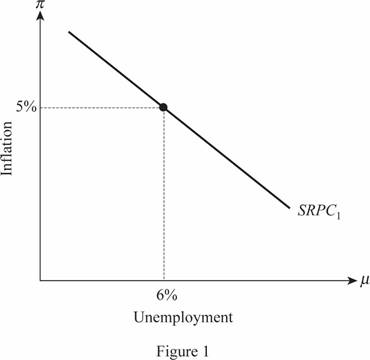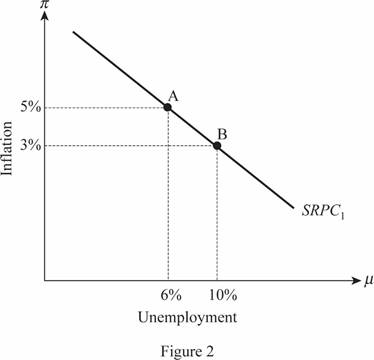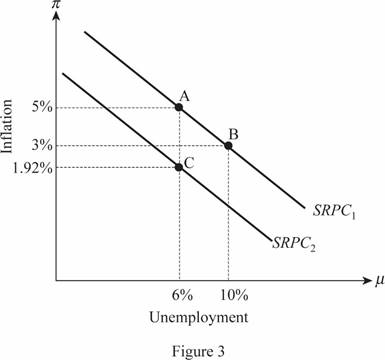
(a)
The natural rate of
(a)
Explanation of Solution
The
Here, the people make their expectations about inflation on the basis of the weighted average of the past two year's inflations. When the inflation rate is stable at 5 percent, it means that the actual inflation is same as the expected inflation and so,
Natural Rate of Unemployment: The natural rate of unemployment is the rate of unemployment that is persisting in the economy when the labor market of the economy is in its equilibrium.
(b)
The short run trade-off between the inflation and unemployment.
(b)
Explanation of Solution
The Phillips curve of the economy is given to be

Thus, the short run trade-off between the inflation which is stable at 5 percentage point and the unemployment which is at its natural rate of 6 percentage point is indicated at point A.
(c)
The impact of fall in aggregate demand short run trade-off between the inflation and unemployment.
(c)
Explanation of Solution
The Phillips curve of the economy is given to be
When the unemployment in the economy rises by 4 percentage points and becomes 10 percentage, the impact on the Phillips curve will be different because the expected inflation in the economy does not change. Thus, the Phillips curve determined the inflation rate and this can be calculated as follows:
Thus, the point B that indicates the change in the trade-off between the unemployment and inflation in the economy which will be on the same short run Phillips curve and can be illustrated as follows:

(d)
The economy during higher unemployment and after 2 years at natural rate for 10 years.
(d)
Explanation of Solution
The Phillips curve of the economy is given to be
When the unemployment in the economy rises by 4 percentage points and becomes 10 percentage, the impact on the Phillips curve will be different because the expected inflation in the economy does not change. Thus, the economy's inflation rate will be 3%. The unemployment rate, inflation rate, expected inflation rate, and the rate of output growth for the 10 years can be calculated in the following table:
| Year | Unemployment Rate | Inflation Rate | Expected Inflation Rate | Rate of Output Growth |
| 1 | 6 | 5 | 5 | 3 |
| 2 | 6 | 5 | 5 | 3 |
| 3 | 10 | 3 | 5 | −5 |
| 4 | 10 | 1.6 | 3.6 | 3 |
| 5 | 6 | 2.02 | 2.02 | 11 |
| 6 | 6 | 1.89 | 1.89 | 3 |
| 7 | 6 | 1.93 | 1.93 | 3 |
| 8 | 6 | 1.92 | 1.92 | 3 |
| 9 | 6 | 1.92 | 1.92 | 3 |
| 10 | 6 | 1.92 | 1.92 | 3 |
(e)
The impact of fall in aggregate demand short run trade-off between the inflation and unemployment.
(e)
Explanation of Solution
The Phillips curve of the economy is given to be
When the unemployment in the economy rises by 4 percentage points and becomes 10 percentage, the impact on the Phillips curve will be different because the expected inflation in the economy does not change. Thus, the Phillips curve determined the inflation rate and this can be calculated as follows:
Thus, the point B that indicates the change in the trade-off between the unemployment and inflation in the economy will be on the same short run Phillips curve. When the unemployment rate falls, the expected inflation rate would fall in the economy. This leads to the downward shift in the short run Phillips curve in the economy. From the table above, it is identified that the expected inflation rate in the economy at the end of the 10th year is 1.92 percent but the unemployment rate is 6 percent. This combination is illustrated at the point C as follows:

(f)
Before recession and after recession equilibrium.
(f)
Explanation of Solution
The Phillips curve of the economy is given to be
After recession, equilibrium is indicated at point C where the inflation rate is 1.92 and the unemployment rate is 6 percentage points. This indicates that the inflation in the economy has been decreased by 3.08 percent points in the economy. While looking at the table for the rate of growth of output, it is identified that there were a loss of 8 percent during from year 2 to year 3, whereas there were a gain of 8 percent from year 3 to year 4. From year 5 to 10, the rate of output growth remained the same which means that there is no long run sacrifice in reducing the inflation rate by the economy.
Want to see more full solutions like this?
- Suppose the Phillips curve in Country A is estimated to be ??=???−0.25(??−?∗?)πt=πte−0.25(ut−ut∗)(supplied in picture) The natural rate of unemployment in the year 2020 equals 3%. Inflation in the year 2020 is expected to be around 1%. The Okun’s coefficient in Country A equals 2. The central bank of Country A is considering three possible monetary policy scenarios for the year 2020. Scenario 1: the central bank performs a monetary contraction, and the inflation rate becomes 0.5%. Scenario 2: the central bank performs a monetary expansion, and the inflation rate becomes 1.5%. Scenario 3: the central bank keeps monetary policy unchanged, and the inflation rate matches expected inflation and equals 1%. For each of these policy scenarios, 1) Determine the corresponding rate of cyclical unemployment in 2020 2) Determine the actual unemployment ??ut that would result in 2020 3) Use Okun’s law to determine the corresponding…arrow_forwardAccording to the St. Louis Federal Reserve the natural unemployment rate is 4.42 percent (Q4 2023 ) and the U.S. Bureau of Labor Statistics (BLS) estimates the U.S. unemployment rate (U3, October 2023 B) to be 3.9 percent. If you expect unemployment to continue to fall the short-run Phillips curve would predict: OA decrease in the inflation rate. An increase in the inflation rate. ○ A decrease in the unemployment rate. ○ An increase in the unemployment rate.arrow_forwardConsider an economy with a natural unemployment rate, u, of 9%. The x = x - 2(u - ū) Assume that Okun's Law holds so that a 1 percentage point increase in the unemployment rate maintained for one year réduces GDP by 2% of full employment output. Note: Okun's Law can be expressed as: Y-Y expectations-augmented Phillips curve is: = -2(u - u) a. Consider a two-year disinflation. In the first year actual inflation, , is 13% and expected inflation, xº, is 17%. What is the first year unemployment rate? % (Enter your response as a percentage rounded to one decimal place)arrow_forward
- Suppose the Federal Reserve sets the real interest rate to 1.5%. Moreover, assume that there are no demand shocks, that b = 2.5, and that F = 0.02. If the resulting change in the inflation rate is +0.375 percentage points, what is the value of the parameter D? (Round to the nearest hundredth.) Hint: Use the IS and Phillips Curves to calculate your answer.arrow_forwardThe Phillips curve in Lowland takes the form of π = 0.04 − 0.6(u − 0.05), where π is the actualinflation rate and u is the unemployment rate. The Phillips curve in Highland takes the form ofπ = 0.08 − 0.4(u − 0.05). The current unemployment rate in both countries is 9 percent (0.09). For both countries, analyze the impact on inflation of a 2% decrease in unemployment? In which country will policymakers face a bigger trade-off if they try to reduce unemployment in the shortrun? Whyarrow_forwardUse the following Phillips curve equation to answer this question: πt - πt-1 = (m + z) - αut. Which of the following will cause an increase in the natural rate of unemployment? A) a reduction in m B) an increase in z C) an increase in α D) a reduction in expected inflation E) none of the abovearrow_forward
- 1. An economy has the following equation for the Phillips Curve: π = Eπ − 0.5(u − 6)People form expectations of inflation by taking a weighted average of the previous two years of inflation: Okun’s law for this economy is: Eπ = 0.7π−1 + 0.3π−2 (Y −Y−1)/(Y-1)=3.0−2.0(u−u−1) Th economy begins at its natural rate of unemployment with a stable inflation rate of 5 percent. Graph the short-run tradeoff between inflation and unemployment that this economy faces. Label the point where the economy begins as A. (Be sure to give numerical values for point A.) A fall in aggregate demand leads to a recession, causing the unemployment rate to rise 4 percentage points above its natural rate. On your graph in part (b), label the point the economy experiences that year as point B.(Be sure to give numerical values.) Unemployment remains at this high level for two years (the initial year described in part (c) and one more), after which it returns to its natural rate. Create a table showing…arrow_forward1. Problems and Applications Q1 Consider the following four situations: A. Actual inflation is 6 percent, and expected inflation is 6 percent. B. Actual inflation is 4 percent, and expected inflation is 6 percent. C. Actual inflation is 4 percent, and expected inflation is 4 percent. D. Actual inflation is 6 percent, and expected inflation is 4 percent.arrow_forwardConsider an economy with a natural unemployment rate, u, of 4%. The expectations-augmented Phillips curve is: = - 0.5(u - ū) Assume that Okun's Law holds so that a 1 percentage point increase in the unemployment rate maintained for one year reduces GDP by 2% of full employment output. Note: Okun's Law can be expressed as: :-2(u-i) How much cyclical unemployment is necessary to reduce inflation by 3 percentage points? Using Okun's Law, compute sacrifice ratio. (Enter an integer number, use only positive values)arrow_forward
- Suppose that an economy has the Phillips Curve π = Tt-1-1.7 (U+- u") If the policymakers pursue a vigilant inflation reduction policy that lowers inflation by 6% points in one period, how much will unemployment rise (in percentage points term)?arrow_forwardAssume the Phillips curve is given by tt = 2nt-1 + Y^t + zt where t is inflation in period t, Y^ t is the output gap in period t, and zt is cost-push inflation in period t. In period 0, inflation is 4%. In period 1, z1 = -0.01 due to an unexpected productivity increase. For all other periods, zt = 0. The output gap is zero all the time. (a) What is inflation in period 1? (b) What is inflation in period 2? (c) What is inflation in period 3? %3Darrow_forwardSuppose that an economy has a phillips curve π=π₋₁ -0.5(u-0.08) a) what is the natural rate of unemployement? b) how much cyclical unemployment is necessary to reduce inflation by 5% points? using okun's Law, compute the sacrifice ratio. c) inflation is runnuing 10%. the fed wants to reduce it to 5%. give two scenarios that will achieve that goal.arrow_forward


 Economics (MindTap Course List)EconomicsISBN:9781337617383Author:Roger A. ArnoldPublisher:Cengage Learning
Economics (MindTap Course List)EconomicsISBN:9781337617383Author:Roger A. ArnoldPublisher:Cengage Learning

 Economics: Private and Public Choice (MindTap Cou...EconomicsISBN:9781305506725Author:James D. Gwartney, Richard L. Stroup, Russell S. Sobel, David A. MacphersonPublisher:Cengage Learning
Economics: Private and Public Choice (MindTap Cou...EconomicsISBN:9781305506725Author:James D. Gwartney, Richard L. Stroup, Russell S. Sobel, David A. MacphersonPublisher:Cengage Learning





